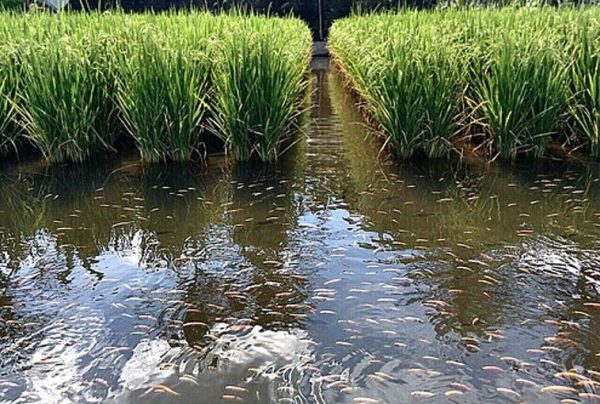
Traditional Cultivation of Fishes In Paddy Field Helps Farmers To Sustain
Cultivating paddy requires lot of water. In Indonesia farmers to make use of water that stands in paddy field started fish culture to get extra income and other benefits. This implementation increased production aby about 20% and helped farmers to sustain. The method of growing paddy and fish in the agriculture field is known as Rice-Fish culture. Rice-fish culture is a traditional and sustainable farming practice in which fishes are raised in flooded rice paddies. This method is prevalent in several parts of Asia, including Indonesia, where it has been practiced for centuries.
Paddy and fish culture is integration of Aquaculture and Agriculture: Rice-fish culture involves the simultaneous cultivation of rice and fish in the same field. This system takes advantage of the symbiotic relationship between the two components. It is an eco-friendly practice that enhances resource use efficiency, improves biodiversity, and boosts farmers’ incomes.
Benefits of rice-fish cultivation:
- Increased productivity: Fish farming in rice paddies can lead to higher overall productivity, as farmers harvest both rice and fish.
- Pest control: Fish help control pests and weeds by eating insects, larvae, and weed seeds (including algae), reducing the need for chemical pesticides and herbicides.
- Nutrient recycling: Fish waste provides nutrients to the rice plants, improving soil fertility and reducing the need for synthetic fertilizers.
- Income diversification: Farmers can generate additional income from selling fish, providing economic stability, and reducing the risk of crop failure.
Which types of fishes are suitable for paddy-fish culture?
Based on their ability to adopt to flooded conditions, fast growth rates, and market demand fish species will be selected. The common fish species that are used in these cultivations are: In Indonesia, common carp (Cyprinus carpio), tilapia (Oreochromis spp.), and various catfish species (Clarias spp.).
Cultivation practices:
- Field Preparation: Rice paddies are prepared with dikes and trenches to hold water and facilitate fish movement. Trenches or canals are often dug along the field edges for fish refuge and movement.
- Stocking: Fish fingerlings are introduced into the paddy fields either before or after rice transplantation. Stocking density varies depending on fish species and local conditions.
- Water Management: Maintaining appropriate water levels is crucial for the survival of both rice and fish. Water levels are adjusted to optimize conditions for both crops and fish.
- Feeding and Care: While fish feed on natural food sources in the paddies, supplemental feeding with rice bran, kitchen waste, or formulated feed can enhance growth.
- Harvesting: Fish are usually harvested before the rice is harvested, although in some systems, fish are harvested periodically throughout the rice-growing season.
The challenges which farmers face while cultivating paddy and fish together are:
Water management: Proper water management is critical and can be challenging, especially in regions with variable rainfall.
Predation and disease: Fish can be vulnerable to predators and diseases, which require monitoring and management.
Labor intensive work: This system can be labor-intensive, requiring more effort in terms of field preparation, water management, and fish care.
Studies in Java and Bali:
Java: In Java, rice-fish culture has been practiced for generations. Farmers typically use common carp and tilapia, which are well-suited to the local conditions.
Bali: In Bali, integrated rice-fish systems often include additional components such as ducks, which further enhance the sustainability and productivity of the system.
Government and NGO support for farmers: The governments where these traditional cultivation practices are present, help farmers with subsidies, training, and support with research findings. Some of the NGO’s also get involved to promote this traditional agricultural practice.
Training programs: Various government and non-governmental organizations offer training and support programs to promote rice-fish culture.
Research and development: Ongoing research aims to improve rice-fish culture practices, develop better fish breeds, and optimize water management techniques.
Subsidies and incentives: Some regions offer financial incentives or subsidies to farmers adopting rice-fish culture to encourage sustainable farming practices.
Future of paddy-fish culture:
Climate change adaptation: Rice-fish culture is seen as a climate-resilient practice that can help farmers adapt to changing environmental conditions.
Food security: By increasing productivity and diversifying income sources, rice-fish culture contributes to food security and rural livelihoods.
Sustainability: This integrated system promotes sustainable agriculture, reducing reliance on chemical inputs and enhancing biodiversity.
Rice-fish culture in Indonesia is a multifaceted agricultural practice that offers numerous benefits for productivity, sustainability, and rural livelihoods. By integrating rice and fish cultivation, farmers can optimize resource use, improve soil health, and create a more resilient farming system.
Reference:
- https://krishijagran.com/
- Rice-fish system – Wikipedia
- https://dof.gov.in/sites/default/files/2020-07/Integrated_Paddy.pdf
- Image credit: By Kembangraps – Own work, CC BY-SA 4.0, https://commons.wikimedia.org/w/index.php?curid=146752016
Author: Sumana Rao | Posted on: May 30, 2024
« Health And Sanitation Are Linked Together Farming In India Offers Profitable Opportunities »






















Write a comment